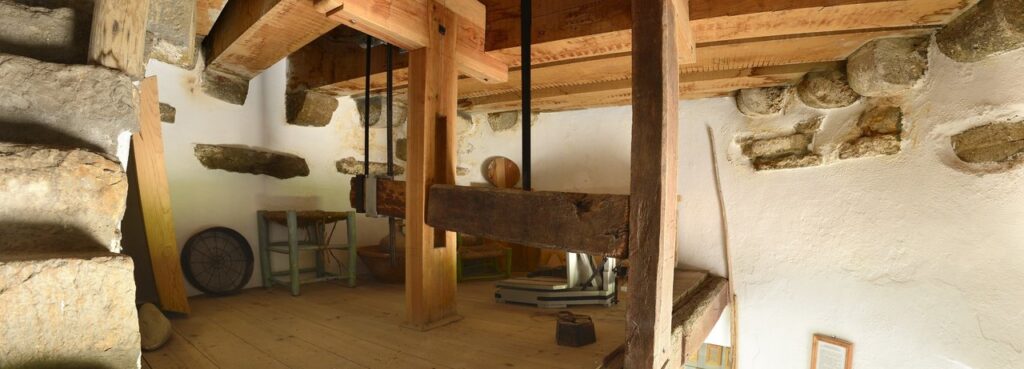The Esteval Moinho de Vento, dated 1826, as evidenced by the inscription of the plaque nailed to one of the beams of the souto, is an emblematic example of the mills called Southern Portugal, with fixed tower in stone masonry and rotating chapel by means of inner windlass.
It is a living testimony to the flouring processes used in the past.
Outside the building, at the top of the door, there is a tile panel of the invocation of N.ªªª da Atalaia, symbol of a very widespread devotion in the region. The same religiosity, in an appeal to divine protection, is visible on the cross inscribed on one of the bears’ supports.
The reconstruction of the mill was carried out by the Municipality under the guidance of the Portuguese International Section of Molinology. The architectural structure has not undergone significant changes, however the wind catching system and the grinding device have been replaced. The mill keeps the traditional grinding system in operation. It opened in 2000.
The operation of the Mill
Typology: Mill in the south of Portugal, with fixed tower and rotating chapel.
Like the specimens of the same typology, the Moinho do Esteval consists of 3 parts:
1. Tower
2. The wind pick-up system or external motor mechanism
3. The grinding device or mill
1. The Tower
It is a tower fixed in stone masonry, cylindrical in shape, with thick walls that narrow slightly upwards. It consists of a ground floor, the ground floor or hell, lined with stone slabs; an intermediate floor, the basement, on which is located the upper mill’s hut; a top floor, the townhouse, on which the upper mill is located. The circulation is made through stone stairs, of a single flight, that develop from the left side of the entrance door, oriented to the Southeast, in the opposite position to the direction of the prevailing winds.
2. The wind pick-up system or external motor mechanism
It consists of the chapel, designation of the mill cover, in a conical shape, formed by a radial structure in wood lined with zinc plated sheet and painted black. The bars of this structure are based on the wooden frame (fechal, more common term), whose wheels rotate on the stone frame. At the top of the chapel there is a vane mounted on a vertical axis that extends into the mill, rotating a pointer that indicates the miller’s wind direction. The rotation of the hood, necessary to point the sails to the wind, is ensured by the windlass.
The mast is the most important element of the external motor mechanism; it is a wooden shaft that crosses the chapel diagonally, supporting, at the end, the rods, in the shape of a cross, four of the sails, which capture the force of the wind, and four of the sails, which stretch them.
3. The grinding device or mill
Moving jointly with the mast, the sprocket, a wheel made up of 32 teeth, engages in the fuselages of the reel, making the wheel move through the savory. The cereal, after being prepared, falls into the bowl (feeder supported by the crow) and slides – through the keel – under the millstone, whose height is regulated according to the grain to be farined. The pressure of the upper stone on the lower one is controlled by the howler that vertically moves the lower support of the shaft, through the spindle.
Crushed by the pressure of the grinding wheel on the ground, the ground cereal is expelled – by centrifugal force – through the open part of the cambeiros, having in front, so that the panal does not spread or become dirty.

